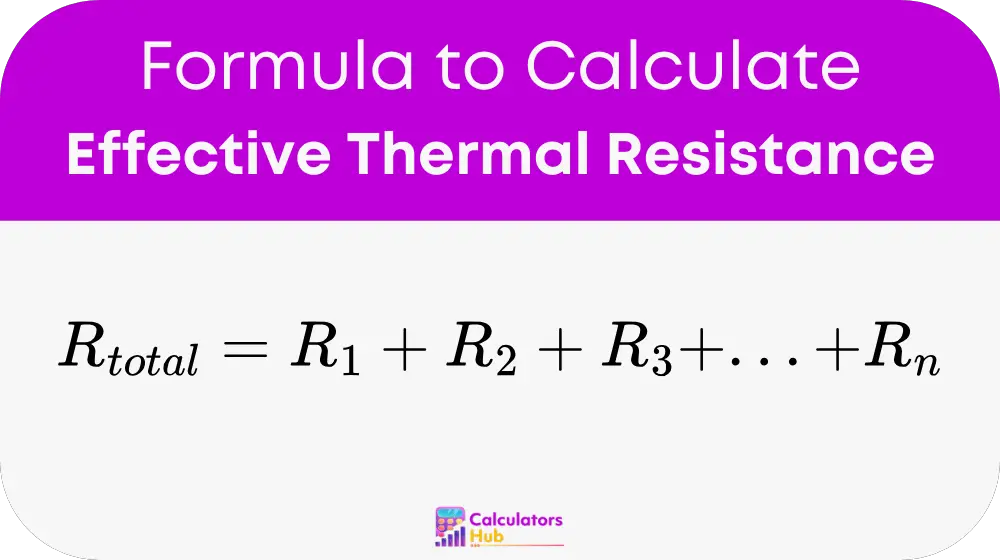有效热阻计算器
图层1
结果:
总有效热阻:
- 有效热阻计算器 帮助你确定结构或材料系统抵抗 流 of 热。该工具在热能工程、绝缘设计、建筑施工和电子冷却方面尤其重要。
当墙壁、设备或系统有多层结构(每层由不同的材料制成)时,计算器会将它们各自的热阻合并为一个总值。这 总阻力 告诉您整个系统抵抗热流的效率。
此工具归类为 热和绝缘性能计算器 并用于工程和实际设计应用。
公式
对于串联层(热流垂直于层):

地点:
- R_总 = 总有效热阻(单位:m²·K/W、ft²·°F·hr/Btu 或类似单位)
- R_i = 第i层或组件的热阻
- R_i 计算公式为:R_i = L_i / (k_i * A_i)
和:
- 利 = 第 i 层的厚度(单位:m、ft)
- _ = 第 i 层材料的热导率(单位:W/m·K、Btu/hr·ft·°F)
- 人工智能 = 垂直于热流的第 i 层的面积(单位:m²、ft²)
备注:如果 人工智能 如果所有层都相同,则可以将其分解。在这种情况下,热阻通常按单位面积计算。
该公式用于热量垂直于每个材料层表面流动的系统(常见于墙壁、屋顶和多层板)。
快速参考通用术语表
| 按揭年数 | 描述 | 常见用例 |
|---|---|---|
| R_总 | 所有层的总热阻 | 用于热建模 |
| R_i | 单层热阻 | 特定层性能 |
| 利 | 材料层厚度 | 保温、壁厚 |
| _ | 材料的热导率 | 描述材料传导热的能力 |
| 人工智能 | 热量流过的表面积 | 当各层区域不同时必填 |
| 平方米·千瓦/瓦 | 热阻的国际单位制 | 公制建筑应用 |
| 平方英尺·°F·小时/Btu | 热阻的英制单位 | 美国建筑隔热等级 |
例如:
让我们计算一下由三层组成的墙壁的总热阻:
- 图层1:
- 材质:砖
- 厚度(L_1)= 0.1米
- 热导率(k_1)=0.6W/m·K
- 面积(A_1)= 10平方米
- 图层2:
- 材质:隔热泡沫
- 厚度(L_2)= 0.05米
- 热导率(k_2)=0.03W/m·K
- 面积(A_2)= 10平方米
- 图层3:
- 材质:木板
- 厚度(L_3)= 0.02米
- 热导率(k_3)=0.12W/m·K
- 面积(A_3)= 10平方米
第一步:计算每一层的R_i
R_1 = 0.1 / (0.6 × 10) = 0.0167 平方米·K/W
R_2 = 0.05 / (0.03 × 10) = 0.1667 平方米·K/W
R_3 = 0.02 / (0.12 × 10) = 0.0167 平方米·K/W
第一步:添加所有 R 值
R_total = 0.0167 + 0.1667 + 0.0167 = 0.2 平方米·千瓦/瓦
回答:总热阻为 0.2 平方米·千瓦/瓦
最常见的常见问题解答
什么是热阻?
热阻是衡量材料或材料组合抵抗热量流动能力的指标。热阻值越高,隔热效果越好,传热速度越慢。
我如何知道是否需要计算有效热阻?
在处理墙壁、天花板、电子设备或任何由不同材料制成的结构时,都需要计算隔热层。它有助于确定有多少热量会通过,以及是否需要增加隔热层。
热阻与 R 值相同吗?
是的,在建筑施工中, R值 是常用的热阻术语。它表示材料的隔热性能,通常以单位面积计算。